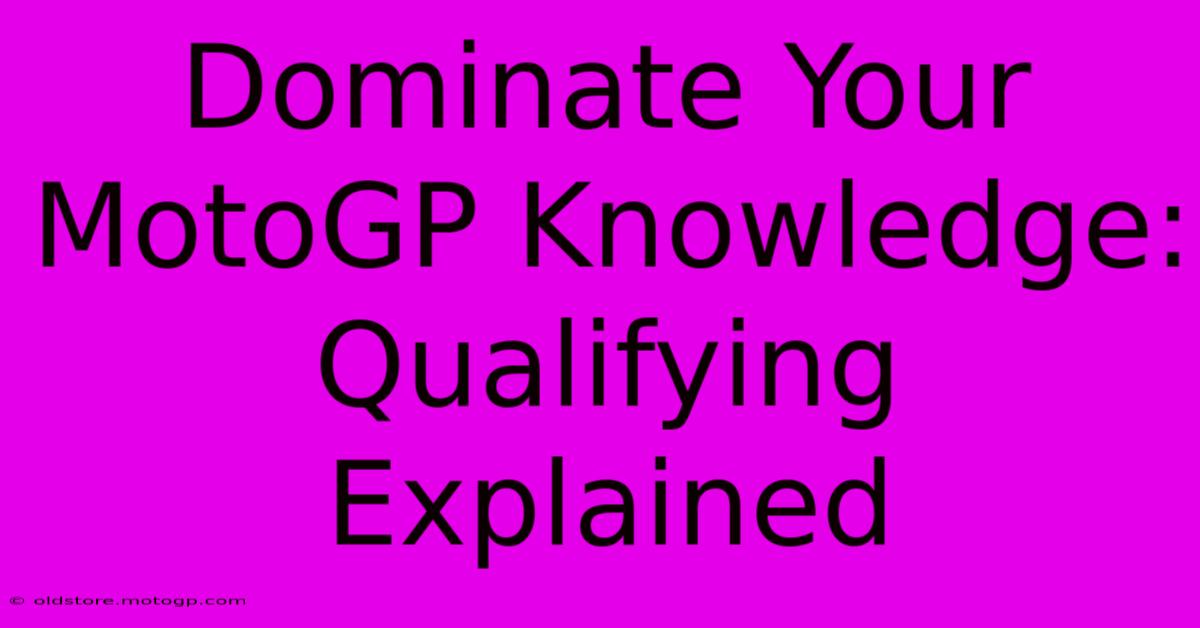Dominate Your MotoGP Knowledge: Qualifying Explained

Table of Contents
Dominate Your MotoGP Knowledge: Qualifying Explained
MotoGP, the pinnacle of motorcycle racing, is a spectacle of speed, skill, and strategy. But understanding the nuances of a race weekend goes beyond just watching the lights go out. A crucial element, often overlooked by casual viewers, is qualifying. This is where grid positions are determined, significantly impacting the race outcome. This comprehensive guide will break down MotoGP qualifying, equipping you with the knowledge to dominate your next MotoGP discussion.
Understanding the Qualifying Format
MotoGP qualifying is a multi-stage process designed to separate the fastest riders from the rest. The current format typically involves three sessions:
Q1 (Qualifying 1):
- Participants: The riders who finished outside the top 10 in the combined times of the Free Practice sessions (FP1, FP2, FP3) participate in Q1.
- Objective: The top two fastest riders from Q1 automatically progress to Q2. This session is crucial for riders battling for a top-12 grid position. The pressure is high, with everyone aiming for that final push.
- Time: A set time limit, typically 15 minutes.
Q2 (Qualifying 2):
- Participants: The top 10 riders from the combined Free Practice times, along with the two fastest from Q1, participate in Q2.
- Objective: This session decides the front of the grid, with the fastest rider claiming pole position. The competition is fierce, with riders constantly pushing the limits of their machines and their skills. Every tenth of a second counts.
- Time: A set time limit, typically 15 minutes.
The Importance of Qualifying
Qualifying is far more than just a preliminary session; it's a critical component of the entire race weekend. A strong qualifying performance offers significant advantages:
- Better Starting Position: A front-row start provides a crucial advantage, allowing riders to control the race from the beginning, avoid early-race chaos, and dictate the pace.
- Track Position: A good starting position often translates to cleaner racing lines, enabling riders to maintain speed and momentum throughout the race.
- Race Strategy: Qualifying performance informs race strategy. A front-row start might allow for a more conservative race approach, while a less favorable position requires a more aggressive strategy.
- Psychological Advantage: Securing pole position provides a significant psychological boost for the rider and the team, increasing confidence and morale.
Factors Affecting Qualifying Performance
Several elements contribute to a rider’s qualifying performance:
- Bike Setup: The optimal bike setup for qualifying might differ slightly from the race setup. Teams spend considerable time fine-tuning the bike for a single flying lap.
- Tire Choice: Choosing the right tires – considering compound and wear – is vital for achieving the best possible lap time.
- Track Conditions: Temperature, humidity, and track surface conditions play a critical role in determining lap times. Adaptability is key.
- Rider Skill and Fitness: Qualifying demands precision, focus, and peak physical condition. Even the smallest mistake can prove costly.
- Teamwork: The support of the pit crew, engineers, and data analysts is crucial for making informed decisions and optimizing the bike's setup.
Mastering the Art of the Qualifying Lap
A MotoGP qualifying lap is a symphony of precision and bravery. Riders push their bikes and themselves to the absolute limit, aiming for perfection in every corner. This involves:
- Consistent Pace: Maintaining a consistent pace throughout the lap is crucial. Any mistake or hesitation can cost valuable time.
- Smooth Lines: Clean and smooth lines minimize time loss and preserve tire life.
- Precise Cornering: Every corner requires expert technique to maximize speed and acceleration.
- Aggressive Acceleration and Braking: Riders need to be fearless in accelerating and braking, pushing the limits of grip and traction.
Understanding the intricacies of MotoGP qualifying significantly enhances the viewing experience. By grasping the format, the importance of the session, and the factors influencing performance, you'll appreciate the strategic depth and intense competition of this critical part of the weekend. So, next time you tune into a MotoGP race, you'll be well-equipped to analyze the qualifying results and understand their impact on the race itself. You'll truly dominate your MotoGP knowledge.

Thank you for visiting our website wich cover about Dominate Your MotoGP Knowledge: Qualifying Explained. We hope the information provided has been useful to you. Feel free to contact us if you have any questions or need further assistance. See you next time and dont miss to bookmark.
Featured Posts
-
Discover Americas Hidden Gems On The Queen Circuit
Feb 22, 2025
-
Experience The Innovation Moto Gp Replicas
Feb 22, 2025
-
F1 Qualifying Cota The Stakes Are High
Feb 22, 2025
-
Elevate Your Performance Shop Moto Gp Helmets For Sale
Feb 22, 2025
-
Austin F1 Map Find Your Way To The Best Viewing Spots
Feb 22, 2025
